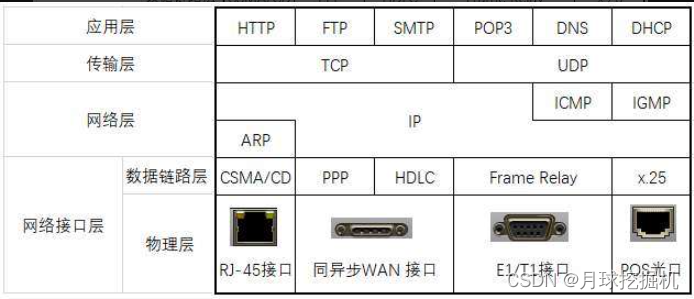The TCP/IP communication protocol is currently the most complete and widely used communication protocol. Its charm lies in enabling computers with different hardware structures and different operating systems to communicate with each other. TCP/IP protocol can be used in both wide area network and local area network, it is the cornerstone of Internet/Intranet. The TCP/IP communication protocol is actually a set of protocols.

 The TCP/IP protocol can be divided into 5 layers or 4 layers, the data link layer and the physical layer can be regarded as the network interface layer
The TCP/IP protocol can be divided into 5 layers or 4 layers, the data link layer and the physical layer can be regarded as the network interface layer
Application layer:
Each application layer protocol defines which requests the client can send to the server (which can also be considered as which commands and the order in which these commands are sent), and which responses the server can return to the client. These request messages and response messages are What fields are there, what function does each field implement, and what the various values of each field represent.
transport layer:
The transport layer has two protocols, TCP and UDP. If the data to be transmitted needs to be divided into multiple data packets and sent, the TCP protocol of the sending end and the receiving end ensures that the receiving end finally receives the transmitted data completely and without errors. If a packet is lost during transmission, the sender will retransmit the lost data packet overtime; if the sent data packet does not arrive at the receiving end in the order it was sent, the receiving end will sort the data packet in the cache and wait for the late data packet, Finally receive continuous and complete data.
The UDP protocol is used in the situation where the data transmission is completed in one data packet. In this case, it is not checked whether the packet is lost, whether the data packets arrive in order, and whether the data transmission is successful are all judged by the application. The UDP protocol is much simpler than the TCP protocol.
Network layer:
The network layer protocol is responsible for forwarding data packets on different network segments and selecting the best forwarding path for data packets. The router in the network is responsible for forwarding data packets on different network segments and selecting forwarding paths for data packets. Therefore, we call routers work at the network layer. It is a network layer device.
data link layer:
The data link layer protocol is responsible for sending data packets from one end of the link to the other. Network devices are connected by network cables or cables, and a segment of network cables or cables connecting network devices is called a link. There are different mechanisms and methods for transmitting data on different links, that is, different data link layer protocols. For example, Ethernet uses CSMA/CD protocol, and point-to-point links use PPP protocol.
physical layer:
The physical layer defines some characteristics related to the network equipment interface and standardizes them, such as the shape, size, number and arrangement of pins, fixing and locking devices, voltage ranges on each line of the interface cable, etc., which can be considered as physical layer protocol.